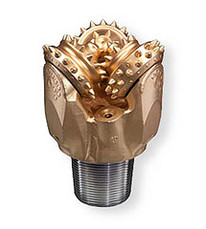A critical decision in the environmental drilling process is choosins the right rotary bits. Since drilling took off in the early part of the last century, a number of innovations have widened your bit choice options. Let's look at some of the more common options available.
What is a tri cone bit?
This kind of bit has three cone-shaped rollers that contain milled steel teeth or diamond tipped cutters. It comes in multiple forms that differ by bit material, teeth milling, and bearing type. The different configurations make this type of drill bit useful in medium and hard formations.
What is a claw bit?
This kind of bit has a number of large fingers, tipped by interchangeable bullet shaped cutters, protruding from the base at an angle. This kind of rotary drill bit works best in soft or medium unconsolidated formations like sandstone, gravel, or shale.
What is a drag bit?
This kind of bit uses the action of the stem rotation to drag the bit over the surface of the formation. With softer formations, like sand, clay, or soft rock, which is found throughout the State of Texas, a drag bit loosens the material sufficiently for the drilling process to proceed. This bit does not work well on layers with coarse gravel or hard rock formations.
What is a roller bit?
This kind of bit uses a set of rolling teeth to break up the formation. The tri-cone bit is specialized form of the roller bit. Other roller bits use two or four legs. Like the tri-cone, roller bits come in many forms appropriate for different formations.
What is a hammer bit?
This kind of bit performs to actions. It hammers into the surface of the formation to break it up, while dragging diamond tipped cutters through the broken material to pulverize it. A hammer bit works well in harder formations like dolomite, sandstone, granite, and limestone.
Most of these drill bit configurations have been around for decades. The manufacturers continuously monitor the performance of their drill bits in the field. That has led to continual innovation and improvements.
Today's drill bits are far more efficient than those of even a couple of decades ago. That speeds up the drilling process, no matter what formation gets in the way. Faster drilling means lower costs for everyone.
If you need environmental drilling for your upcoming project, please contact Talon/LPE. We have the equipment and experience needed to handle any project you have. With offices throughout Texas, New Mexico and Oklahoma, we have the expertise to determine which type of drilling is best suited for the soil and geology of your project site.

